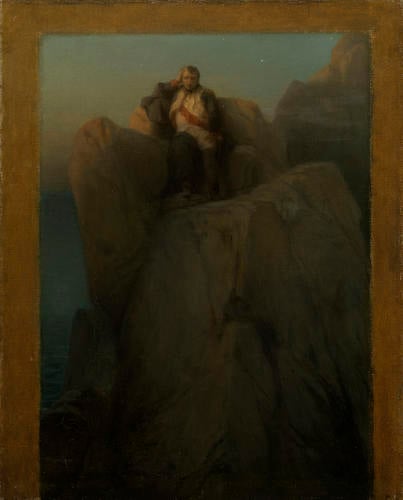Napoleon at St Helena c. 1855-6
Oil on canvas | 40.9 x 32.5 cm (support, canvas/panel/stretcher external) | RCIN 404876
-
Napoleon, full-length, seated on a ledge on a promontory overlooking the sea. He faces the spectator, resting his head on his right hand, his right elbow propped on a niche in the rock beside him; he wears a brooding or melancholic expression.
This oil sketch was made in preparation for an enormous canvas featuring the massive, brooding figure of the exiled Emperor. A large preparatory drawing, photographed by Robert Bingham on the wall of Delaroche's studio for a catalogue, was later destroyed, it is therefore the Royal Collection's oil sketch that formed the basis for the engraving by CW Sharpe, published in the 'Art Journal' in 1860.
It may seem strange for an English Queen to have purchased a picture of Napoleon Bonaparte (1769-1821), but in this respect Queen Victoria was in touch with the fashion in England and on the Continent during the middle years of the nineteenth century for collecting Napoleonica. The Queen’s uncle, George IV, had likewise acquired a number of memorabilia of his supposed arch-enemy. In the collection of the 4th Marquess of Hertford (1800-1870), who had formed a close friendship with Prince Louis Napoleon (later the Emperor Napoleon III) in London in the late 1830s, there were numerous paintings and watercolours on Napoleonic themes (Ingamells 1986, p. 11). The revolutions of 1830 and 1848 revived Napoleon I’s reputation, and he came to be seen more often as a symbol of enlightened progress and military expertise than of dictatorship and defeat. His delayed state funeral and the interment of his ashes at the Invalides in Paris had been investigated by King Louis-Philippe in a spirirt of reconciliation, and Queen Victoria and Prince Albert visited the tomb during the State Visit to Paris in August 1855. Queen Victoria wrote of the occasion, which was recorded in a canvas by E. M. Ward (RCIN 402019), ‘I stood on the arm of Napoleon IIIrd before the coffin of his Uncle, our bitterest foe. I, the granddaughter of that King, who hated Napoleon most…& this very nephew, bearing his name now my nearest & dearest ally!' (Journal, 24 August, 1855).
Hippolyte Paul Delaroche (1797-1856) was one of the most famous painters of the mid-nineteenth century, with patrons throughout Europe and beyond. Although the first of his portraits of Napoleon was produced over twenty years after his exile from Europe, (and Delaroche was barely an adult at the time of Waterloo) the verisimilitude of his portraits was attested by people who had seen the Emperor in his prime. Nineteenth-century patrons could not believe that the artist had not actually set eyes upon his mighty model, but there is no evidence that he had. This series of four paintings, began in 1838, ended with the St Helena portrait, a project unfinished at the time of the artist's death in 1856. The first, Napoleon in his Study (1838), was commissioned by the Countess of Sandwich; Napoleon at Foutainbleu, and Napoleon Crossing the Alps, exist in several versions, including repetitions and reductions.Provenance
Purchased at the sale of Delaroche's studio in Paris, 1857; given by Queen Victoria to Prince Albert, 26 August 1858; recorded at Osborne House, 1876
-
Medium and techniques
Oil on canvas
Measurements
40.9 x 32.5 cm (support, canvas/panel/stretcher external)
61.4 x 50.9 x 7.7 cm (frame, external)
Alternative title(s)
Napoleon Bonaparte (1769-1821) at St. Helena










